Edible Seaweeds
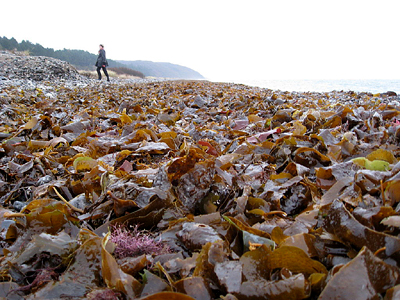
By Filip Tkaczyk
Edible Seaweeds are one of the sensory delights of the living seashore. With their fantastic shapes, colors and tastes they are quite an experience for the adventurous palate. They can also be a valuable survival food.
There are many different kinds of seaweeds which are considered edible, and only a few to avoid. Many of us, even those who have not eaten seaweed in its regular form have consumed it in the form of carrageenan. This is a food additive, most commonly used as a thickener, and is added to beers, ice cream, vegetarian hotdogs, soy milk and many other products, even toothpaste!
What are seaweeds?
Seaweeds are a type of complex algae, and most of them grow from an attachment on rocks or the sea floor. One of the exceptions to this is Sargasso seaweed, a ubiquitous floating seaweed found especially in the Sargasso sea. Some grow as thin, sheet-like mats covering rocks. Others form hair-like filaments that wave with the movement of the water. The most famous are the giant seaweeds such as giant kelp and bull kelp, which can grow to well over 100 feet long!
Where to start?
Edible seaweeds are most abundant along temperate coastlines, especially on rocky shorelines. Do some research in a local field guide to find out what some of the most common species are in your area. Learn about and sample one at a time. Take it slow, eat a very small amount at first, and watch how your body responds to this new wild food.
But before you even harvest any remember to verify the following things: First, is this area relatively pristine? You don't want to eat seaweeds from polluted areas. Second, what are the local laws regarding harvesting seaweeds? In some places, harvesting is highly regulated and likely rightfully so in order to protect them from over-harvesting. Respect laws and only harvest where permitted or acquire the appropriate permits and permission to do so.
When harvesting, cut seaweeds so that you leave the base/attachment intact. This will allow it to regrow.
Common Edible Seaweeds
Here are some of the best species to start with as you learn more about seaweeds:
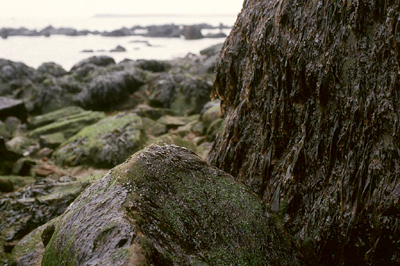
Porphyra - Also called "nori" or "laver." This is a common, purple-green, sheet-forming seaweed that grows from attachments on exposed rocks. It contains high levels of vitamin B12.
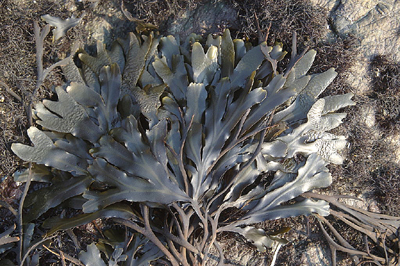
Fucus - Also known as "bladderwrack" for the little pods present on their fronds. Species in this group have been shown to contain a wide-variety of minerals and essential proteins. Some have argued this is one of the few "complete foods" on the planet. These seaweeds contain iodine, which can cause allergic reactions in those sensitive to iodine.
Be More Prepared For Your Next Outdoor Adventure!

Don't leave home without knowing these six essential survival skills. Our free survival mini guide reveals the strategies of:
- Shelter & fire to prevent the number one cause of death
- Obtaining clean water to avoid life-threatening dehydration
- Common wild survival foods and other critical skills!

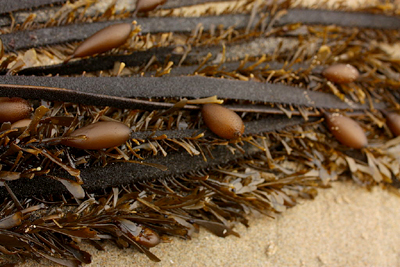
Egreria menziesii - Also called "feather boa kelp." This aptly named seaweed looks like a brownish version of the more familiar feather boas.
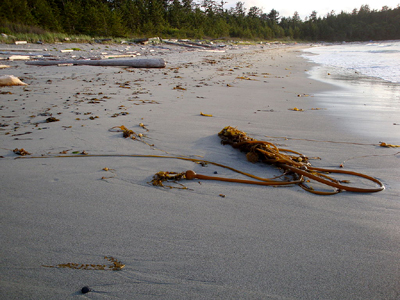
Nereocystis luetkeana - More commonly known as "bull kelp" or "bullwhip kelp." This giant kelp species has one long stalk with a singly, bulbous bladder filled with gas to help it float. From this bladder, there is a series of soft, elongated fronds. This species can be turned into kelp pickles.
Cautions
The only seaweeds to avoid are those belonging to the "acid kelp" group, especially the Desmarestia genus. These seaweeds contain sulfuric acid, which they release when damaged. It may be enough to cause upset stomach at the very least.
Do not eat any seaweed you haven't positively identified with the help of an expert or multiple field guides. Also, be cautious when trying positively identified edible seaweeds for the first time. This is true for any new wild edible, as everyone's body is different, so all wild edibles must be approached with care and eaten in moderation.
Happy seaweed foraging!
By the way, when you're out foraging for wild plants and mushrooms, it's important to know how to stay safe in the outdoors, especially if you were to get lost. Right now you can get a free copy of our mini survival guide here, where you'll discover six key strategies for outdoor emergencies, plus often-overlooked survival tips.
Additional Resources:
For detailed information on edible seaweeds visit Ryan Drum's site.

About the Author: Filip Tkaczyk is a periodic guest teacher at Alderleaf. He also wrote the field guide Tracks & Sign of Reptiles & Amphibians. Learn more about Filip Tkaczyk.
Return from Edible Seaweeds back to Wild Plants Articles
Is The Essential Wilderness Survival Skills Course Right for You? Take the "Online Survival Training Readiness" Quiz
See for yourself if this eye-opening course is a good fit for you. It takes just a few minutes! Get your Survival Training Readiness Score Now!

Grow Your Outdoor Skills! Get monthly updates on new wilderness skills, upcoming courses, and special opportunities. Join the free Alderleaf eNews and as a welcome gift you'll get a copy of our Mini Survival Guide.

 The Six Keys to Survival: Get a free copy of our survival mini-guide and monthly tips!
The Six Keys to Survival: Get a free copy of our survival mini-guide and monthly tips!
Learn more